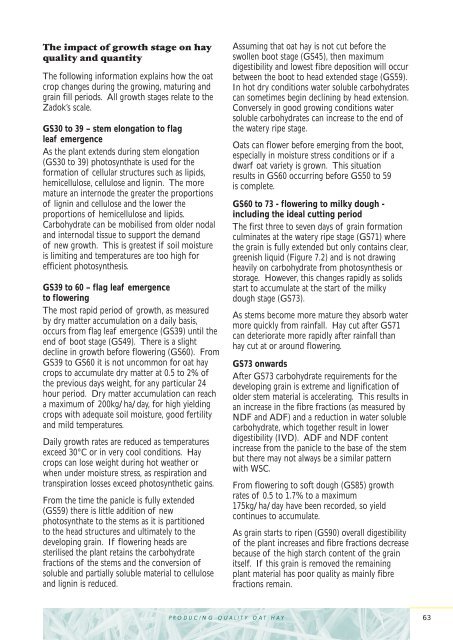Create successful ePaper yourself
Turn your PDF publications into a flip-book with our unique Google optimized e-Paper software.
The impact of growth stage on hay<br />
quality and quantity<br />
The following information explains how the oat<br />
crop changes during the growing, maturing and<br />
grain fill periods. All growth stages relate to the<br />
Zadok’s scale.<br />
GS30 to 39 – stem elongation to flag<br />
leaf emergence<br />
As the plant extends during stem elongation<br />
(GS30 to 39) photosynthate is used for the<br />
formation of cellular structures such as lipids,<br />
hemicellulose, cellulose and lignin. The more<br />
mature an internode the greater the proportions<br />
of lignin and cellulose and the lower the<br />
proportions of hemicellulose and lipids.<br />
Carbohydrate can be mobilised from older nodal<br />
and internodal tissue to support the demand<br />
of new growth. This is greatest if soil moisture<br />
is limiting and temperatures are too high for<br />
efficient photosynthesis.<br />
GS39 to 60 – flag leaf emergence<br />
to flowering<br />
The most rapid period of growth, as measured<br />
by dry matter accumulation on a daily basis,<br />
occurs from flag leaf emergence (GS39) until the<br />
end of boot stage (GS49). There is a slight<br />
decline in growth before flowering (GS60). From<br />
GS39 to GS60 it is not uncommon for oat hay<br />
crops to accumulate dry matter at 0.5 to 2% of<br />
the previous days weight, for any particular 24<br />
hour period. Dry matter accumulation can reach<br />
a maximum of 200kg/ha/day, for high yielding<br />
crops with adequate soil moisture, good fertility<br />
and mild temperatures.<br />
Daily growth rates are reduced as temperatures<br />
exceed 30°C or in very cool conditions. <strong>Hay</strong><br />
crops can lose weight during hot weather or<br />
when under moisture stress, as respiration and<br />
transpiration losses exceed photosynthetic gains.<br />
From the time the panicle is fully extended<br />
(GS59) there is little addition of new<br />
photosynthate to the stems as it is partitioned<br />
to the head structures and ultimately to the<br />
developing grain. If flowering heads are<br />
sterilised the plant retains the carbohydrate<br />
fractions of the stems and the conversion of<br />
soluble and partially soluble material to cellulose<br />
and lignin is reduced.<br />
PRODUCING QUALITY OAT HAY<br />
Assuming that oat hay is not cut before the<br />
swollen boot stage (GS45), then maximum<br />
digestibility and lowest fibre deposition will occur<br />
between the boot to head extended stage (GS59).<br />
In hot dry conditions water soluble carbohydrates<br />
can sometimes begin declining by head extension.<br />
Conversely in good growing conditions water<br />
soluble carbohydrates can increase to the end of<br />
the watery ripe stage.<br />
<strong>Oat</strong>s can flower before emerging from the boot,<br />
especially in moisture stress conditions or if a<br />
dwarf oat variety is grown. This situation<br />
results in GS60 occurring before GS50 to 59<br />
is complete.<br />
GS60 to 73 - flowering to milky dough -<br />
including the ideal cutting period<br />
The first three to seven days of grain formation<br />
culminates at the watery ripe stage (GS71) where<br />
the grain is fully extended but only contains clear,<br />
greenish liquid (Figure 7.2) and is not drawing<br />
heavily on carbohydrate from photosynthesis or<br />
storage. However, this changes rapidly as solids<br />
start to accumulate at the start of the milky<br />
dough stage (GS73).<br />
As stems become more mature they absorb water<br />
more quickly from rainfall. <strong>Hay</strong> cut after GS71<br />
can deteriorate more rapidly after rainfall than<br />
hay cut at or around flowering.<br />
GS73 onwards<br />
After GS73 carbohydrate requirements for the<br />
developing grain is extreme and lignification of<br />
older stem material is accelerating. This results in<br />
an increase in the fibre fractions (as measured by<br />
NDF and ADF) and a reduction in water soluble<br />
carbohydrate, which together result in lower<br />
digestibility (IVD). ADF and NDF content<br />
increase from the panicle to the base of the stem<br />
but there may not always be a similar pattern<br />
with WSC.<br />
From flowering to soft dough (GS85) growth<br />
rates of 0.5 to 1.7% to a maximum<br />
175kg/ha/day have been recorded, so yield<br />
continues to accumulate.<br />
As grain starts to ripen (GS90) overall digestibility<br />
of the plant increases and fibre fractions decrease<br />
because of the high starch content of the grain<br />
itself. If this grain is removed the remaining<br />
plant material has poor quality as mainly fibre<br />
fractions remain.<br />
63

















